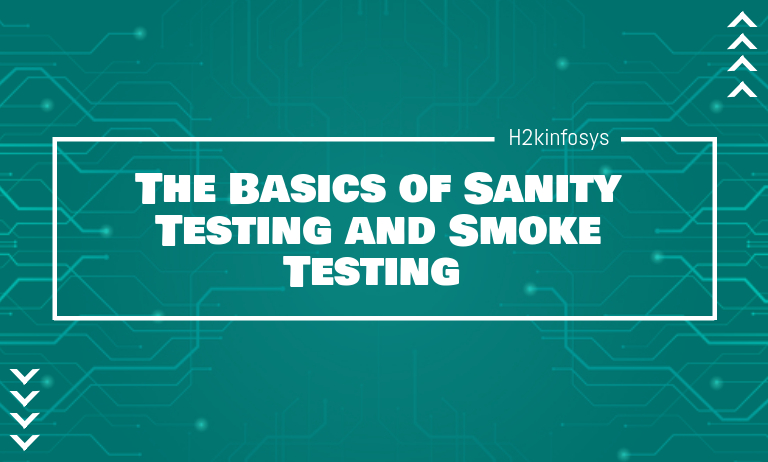The Basics of Sanity Testing and Smoke Testing

Software Testing is a vital field in today’s technology driven world. It has become a crucial aspect of the digital world because it plays an important role in the development of unique and efficient software across different platforms.
There are several aspects of Software Testing and each one has its unique function in the development process of software applications. In this guide I will introduce you to two different types of Software Testing. This includes;
- Sanity Testing
- Smoke Testing
Sanity Testing and Smoke Testing are two crucial aspect of Software Testing that offers a wide range of purpose when building a software. They are very effective but are often interchangeably used which makes it difficult to tell the difference.
There are instances where both are compared to “Build Validation Test” but they are executed at different stages during a software testing circle. However, they are quite different from each other because they are applied in different forms.
The Main Purpose of Carrying Out Sanity Testing and Smoke Testing
- It helps to avoid time and energy wasted in passing an application through a rigorous test. It determines if an app can cross to the next testing stage.
- It is important to carry out both testing technique during a software build as it ensures a more effective functionality.
- These testing techniques are used to speed up further testing procedures and software testing executions in later stages.
- It is an industry standard to execute Sanity Testing and Smoke Testing during a software build or while working on a software project.
Now that you’ve been introduced to the reason why these testing procedures are important, I will like to explain the meaning of each of these testing techniques.
Introduction to Sanity Testing and Smoke Testing
The first step in this tutorial is to explain the meaning of these different Software Testing techniques. This will give you a better understanding of the topic.
Sanity Testing:
Sanity Testing is a form of “testing checkpoint” that is performed when building a software so as to ensure that code changes implemented are working perfectly without glitches. This software technique is very reliable when a new build is passed through a development testing process and one of its major features is to identify functionalities that are missing. This will make you determine if a section of your program is working as expected when you make minor changes.
When you receive a Software Build with changes in code or functionality, it is very important to conduct Sanity Testing. This is to check if a particular bug has been fixed and there’s no new glitch developed due to the changes made. So the main aim is to ensure that a particular software functionality is working as proposed.
NOTE: The testing of a build can only proceed if it passes Sanity Testing process.
Smoke Testing:
Smoke Testing is a software testing technique that is performed after receiving a Software Build. This simply means that the testing process is carried out to verify if the basic functionalities of a software is working perfectly. In other words, this test is carried out to check the build functionality of a system.
This software testing technique is a build acceptance or initial level test executed before functional testing, to test initial steps for readiness of software for in-depth functionality testing. The importance of executing this test is to prevent the Quality Assurance Team from carrying out further test on a faulty system application. This prevents exhaustive testing.
NOTE: The software build will be declared unstable and the testing process can’t continue until the build functionality passes the Smoke Testing procedure.
Basic Features of Sanity Testing and Smoke Testing
Let’s take a closer look at the basic features of these software testing techniques.
Basic Features of Sanity Testing:
- Sanity Testing is usually unscripted which means they are not planned.
- Sanity testing involves verification of system rules and functionality.
- It is deep and narrow which means if focuses on specific functionalities.
- This testing is carried out at random to ensure functionalities are working.
- This test helps to determine if a developer applied certain rationality when building the software.
- It is executed to determine if a section of application is working after certain changes and fix.
Basic Features of Smoke Testing:
- Smoke Testing can be automated or executed manually.
- It involves designing the basic functionality of an application.
- Smoke Testing helps to identify critical functionalities of components.
- Every build stage is passed through smoke testing before further testing.
- It is used to discover bugs and errors so as to prevent stressing test teams.
- It ensures that the fundamentals of software builds are very effective.
- Smoke Testing is designed to be shallow and wide which means it cuts across all parts of the software application.
These basic features listed above will give you a clear view of both Software testing techniques. Ensure you study it so as to understand the difference between the two testing procedures. However, the next step will spell out these differences in form of a table. So, ensure you keep reading the article.
Major Differences between Sanity Testing and Smoke Testing
Sanity Testing is quite similar to Smoke Testing and as discussed earlier, it can be a bit confusing. Therefore, I will show you a detailed breakdown of key features of both Software Testing techniques. This will be explained by using a table for better understanding.
| SANITY TESTING | SMOKE TESTING | |
| 1. | It is a subset of Regression Testing | It is a subset of Acceptance Testing |
| 2. | The System Builds subjected to this testing are Stable Builds | The System Builds subjected to this testing are Initial Builds |
| 3. | The testing time schedule spans over two to three days | The testing time schedule spans over minutes or hours |
| 4. | It is used to verify if functionalities that were newly added are working | It is used to verify if implementations carried out are working perfectly |
| 5. | The motive of this testing is to evaluate critical functionalities of System Builds | The motive of this testing is to ensure new builds can pass through further rigorous testing stages |
| 6. | Sanity Testing are unscripted | Smoke Testing are scripted |
| Sanity Testing is narrow and deep | Smoke Testing is shallow and wide | |
| 7. | This test focuses on a specific area of system functionality | This test cuts across several parts of system functionality and application |
| 8. | A particular system component is analyzed when carrying out this test | The entire system is analyzed from end to end when carrying out this test |
| 9. | This testing is mainly performed by application testers | This testing is mainly performed by both application testers and developers |
The table above shows differences between Sanity Testing and Smoke Testing.
Conclusion
The major differences between Sanity Testing and Smoke Testing have been explained in this guide. Both system testing techniques are very reliable and effective. The results can be trusted if you follow the procedures strictly. One important thing to understand is that Sanity Testing is like performing a specific health checkup on a system application while Smoke Testing is like performing a general health checkup on a system application. I believe this guide will be very helpful on your journey to learn the basics of Software Testing.





